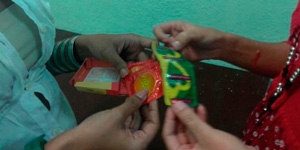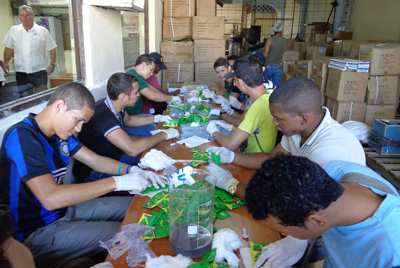Cuba Faces Condom Shortage
By José Jasán Nieves Cárdenas (Progreso Weekly)

HAVANA TIMES — The iffy supply of condoms in Cuban pharmacies and markets in recent months has meant greater risk for some and an impediment to others who prefer to restrain their libidos rather than fall sick or become pregnant.
The situation seems to have worsened since early April but has been intermittent for more than a year, in another recurring episode of bureaucratic mismanagement and shortages.
“I don’t know what’s happening, but I know that they’re not available,” says a young student of medicine, who adds a warning about the danger posed by the lack of condoms. “The indices of pregnancies and abortions are up, and so are the sexually transmitted diseases,” (STD) he says.
The condom conundrum
According to the Public Health Ministry, the interruption in the distribution of “preservativos” occurred because of the need to repackage millions of units of the “Momentos” brand, which arrived from China showing an expiration date of 2012 although they’re good until late 2014.
The process meant recalling the product throughout the island and relabeling it, in the absence of new supplies of other brands or even the same brand.
Evidently, it has been impossible to solve the problem quickly, because the health authorities on April 7 authorized the sale of condoms without correcting the “printing error,” according to an announcement by the Medical Supplies Enterprise and the Center for the State Control of Medications, Medical Equipment and Devices (CECMED).
As articles for medical use, condoms are heavily subsidized, because the price of a strip of three units is barely 1 peso — less than five cents of a dollar. But the fact that they are a product managed only by the health authorities means that the market leaves little room to choose.

“Although the Momentos condoms have never been among the better accepted, they’re the ones that the government bought and they’re the only ones that are available until year’s end,” admits one of the specialists in the STD/HIV/AIDS-prevention program.
He sides with those who say that Cuba does not import products from wherever it wants but from wherever it can, due to the lack of money and the U.S. embargo.
Until recently, Cubans could buy other condoms sold under the brand names “Love” and “Vigor” (the latter a product financed by the United Nations World Fund) but the contract with the makers of the former was not renewed and the latter used up the five years of international financing it had for its production.
Not just quantity; quality, too
“The Momentos are supposed to be tested electronically, but I don’t believe that because, when you open them, it is obvious that they have very little lubricant,” says Claudia Martínez, a young radio reporter in south-central Cuba.
“I’ve found that the condoms sometimes break,” says a 19-year-old girl. Her opinion on the quality of the available condoms coincides with those of many others.
“The number of condoms that break matches the proportion established by the international parameters,” says Ramiro Espinosa González, chief of the anti-AIDS program in Cienfuegos province.
“There are condoms with better quality and others with standard quality, but all meet the international requirements for safety,” Espinosa says. “When they break, it’s almost always because of the improper technique used to slip them on.”
According to medical indicators, for a population to consider itself “sexually protected,” it must use condoms in at least 73 percent of all the acts of copulation.
The reality in Cuba is far from that objective. In a small province like Cienfuegos (pop. 400,000) only 28 percent of the sexually active population uses prophylactics, yet it’s one of the provinces with the highest condom usage.
Colors and types of every variety
Some users are advocating an increase in the supplies but without state subsidy, so as not to depend on just one option.
In some stores, condoms are sold in convertible pesos, or CUC, a unit of currency equivalent to one dollar or 24 “national” pesos, or CUP, but the prices are a strain on a Cuban’s average income. A box can cost as much as 1.80 CUC (almost 50 CUP), one-eighth of the average monthly wage in Cuba.
In the face of a fluctuating supply, a momentary solution is solidarity.
“Friends tell each other who has [condoms] and where. They share a few of them, because the only option is abstinence, if we don’t want to contract a disease or become pregnant,” says blogger Alejando Ulloa, one of the many young men who have to walk up and down the streets of the capital to find a condom or the answer to why they disappeared.






Sorry John, you must have bad sources. UNICEF shows child malnutrition in Cuba on the current Cuba page.
5% of children under 5 in Cuba suffer malnutrition according to the Cuba page.
http://www.childinfo.org/files/nutrition/DI%20Profile%20-%20Cuba.pdf
The Castro regime has never allowed any outside organization to conduct an independent study of Cuba’s healthcare system. The reports you may have seen from UNICEF, WHO, and any other UN related organization refer to data handed to them by the Cuban government. The accuracy of the data has never been independently checked.
UNICEF, a branch of the United Nations and hardly a friend of Cuba has certified Cuba as the only country in Latin America to eliminate childhood malnutrition.
You forgot to mention this salient fact.
This despite the 54 year long economic war waged against the population of Cuba in which every man, woman and child suffers food shortages and a threatened nutritional level because of that war.
You also forgot to mention this fact in your haste to defame Cuba’s revolution.
Cuba has survived your war on them and will continue to survive and then thrive when that war ends in the next ten years.
As for not fooling you : I make no attempts to fool you .
It is said that is easier to fool someone than it is to get them to believe that they have been fooled.
My posts are factual and backed up by sufficient material and sourcing . You did not cite your sources .
Malnutrition is near non-existent in Cuba.
Anemia -iron deficiency – is widespread thanks to the embargo.
Like the fighter pilots in those old W.W.II flicks whose planes, having been mortally wounded, were advised to “!Pull Out!” “!Pull Out!” They never do, of course, and their planes spiral down into spectacular crashes. The current condom crisis yokes together both LOVE and DEATH! Since orgasm has been called “the little death,” and unprotected sex, besides STD’s, oft results in life, perhaps there is a method in this shortage (i.e. averting a demographic crisis twenty to thirty years hence, with too many retirees and not enough Cubans still in the work force). Still, unplanned and unwanted children are not the answer; for the most part they are neglected, often raised by parents–usually one parent, the mother–unprepared for parenthood, with inadequate mental, physical and economic resources. Often, the children of such unions wind up psychically damaged and unproductive as adults.
LOL Moses… Condoms on hand??? I guess that is real safe sex…
Cuba has people lining up for hours to buy some potatoes. the little food they get – unless they have access to dollars – is one-sided (rice and beans) and leavens Cubans with widespread vitamin deficiency and high rates of anemia – mainly children and pregnant women – and diabetes (the elderly).
The WFP has ran various programs – mainly in Oriente – to give vitamin biscuits to school age children.
Malnutrition is widespread in children. Anemia and vitamin deficiency being the two main problems for children under 5.
The health care system – destroyed by lack of investment and depleted of staff by the “doctors for rent scheme” – is a complete disaster as the descriptions of hospitals and the stories of patients widely reported show.
Hohn, lots of us know Cuba very well. You can’t fool us.
CBS investigated and found that – as always – condoms were available in Havana but were lacking outside the city with the worst situation being in Santiago de Cuba.
As always: the further you go east from Havana the worse it gets. Oriente has always and – it seems – will always be worse off than the metropolis.
Cuba has one of the healthiest and well-nourished populations in the hemisphere.
It is the ONLY Latin American country without childhood malnutrition.
Their health care system is able to supply health care to many other poor CAPITALIST countries where the poor have no health care .
It appears you don’t know what you’re talking about.
I totally agree with you Moses! They are not intelligent enough to organized themselves properly and their lack of organzation is hazardous for the population’s health.
This is clearly a result of central planning. It continues to amaze me when Castro supporters proclaim the loss of scientific and social engineering exchange between the US and Cuba because of currently chilled relations when these Castro bozos can’t even manage to keep a supply of condoms on hand.